Size-Segregated Particulate Matter from Gasification of Bulgarian Agro-Forest Biomass Residue
Abstract
1. Introduction
2. Materials and Methods
3. Results
3.1. Gaseous Products—Syngas
3.2. Solid Particles
4. Conclusions
- The introduction of CO2 increased the production of CO and CH4, while there was a decrease in CO2 and H2. The syngas LHV was also slightly higher. These results enhanced the CGE and CCE.
- Because CO2 decreased the production of H2, it resulted in a lower H2/CO ratio. Rapeseed had the highest H2/CO ratio and the highest carbon conversion efficiency, while softwood had the highest cold gas efficiency. Most of the generated syngas can be used for the synthesis of higher hydrocarbons since the H2/CO ratio was between 0.25 and 0.9.
- Another effect of CO2 containing gasifying atmosphere was the lowered emissions of cyclone particles, while the total mass of the PM10–0.03 has increased regardless of the biomass type. Particulates of submicron size were the dominant fraction (PM1–0.3) in O2/N2 and PM1.6–0.3 in O2/N2/CO2. Unimodal PM size distribution was observed, except for sunflower husks gasification in O2/N2/CO2, for which bimodal PM distribution was determined. All PM peaks in the CO2 atmosphere were slightly shifted to the right, but still in the submicron range of PM size. The effect of CO2 concentration (in the gasifying atmosphere) and the temperature was not subject to the present work. However, further optimization experiments are required, aiming to reduce the overall PM yield while keeping the process efficiency or even improving it.
- The SEM/EDS and the XPS results confirmed that submicron-sized PM contains above 80% of carbon, which is considered to be mainly soot, formed due to the incomplete biomass oxidation. The carbon content gradually decreased in the larger particulates, reaching about 50% in cyclone (char) particles, on the account of the ash mineral composition. The SEM/EDS results confirmed that alkali metals, such as K and Cl were typical constituents of the submicron size PM, whereas the alkaline earth metals were found in the fine and coarse particles. Detailed analysis of the XPS (C1s, O1s, Si2p, and Cl2p) spectra allowed determining the most common oxygen-containing carbon groups on the PM1 surface (carbonyl and carboxyl), along with the appearance of –C–OH, –CH–CH, and aryl groups, as well as inorganic and organically bound mineral compounds (e.g., SiO2, organically bound Si and Cl).
Author Contributions
Funding
Institutional Review Board Statement
Informed Consent Statement
Data Availability Statement
Acknowledgments
Conflicts of Interest
References
- Popp, J.; Lakner, Z.; Harangi-Rákos, M.; Fári, M. The effect of bioenergy expansion: Food, energy, and environment. Renew. Sustain. Energy Rev. 2014, 32, 559–578. [Google Scholar] [CrossRef]
- Koleva, E.G.; Mladenov, G.M. Renewable Energy and Energy Efficiency in Bulgaria. Prog. Ind. Ecol. 2014, 8, 257–278. [Google Scholar] [CrossRef]
- Zhang, Y.; Kajitani, S.; Ashizawa, M.; Oki, Y. Tar Destruction and Coke Formation during Rapid Pyrolysis and Gasification of Biomass in a Drop-Tube Furnace. Fuel 2010, 89, 302–309. [Google Scholar] [CrossRef]
- Zhai, M.; Zhang, Y.; Dong, P.; Liu, P. Characteristics of Rice Husk Char Gasification with Steam. Fuel 2015, 158, 42–49. [Google Scholar] [CrossRef]
- Stevens, D.J. Hot Gas Conditioning: Recent Progress with Larger-Scale Biomass Gasification Systems; National Renewable Energy Lab.: Golden, CO, USA, 2001. [Google Scholar] [CrossRef]
- Stoilov, S.; Marinov, K.I.; Gochev, Z. Biomass Potential of Bulgarian Forest-Based Sector for Energy Production. In Proceedings of the 6th International Science Conference “Chip and Chipless Woodworking Processes”, Šturovo, Slovakia, 11–13 September 2008. [Google Scholar]
- Bell, D.; Towler, B.; Fan, M. Coal Gasification and Its Applications; Elsevier Inc. 2010. Available online: https://www.sciencedirect.com/book/9780815520498/coal-gasification-and-its-applications?via=ihub=#book-info (accessed on 8 January 2021). [CrossRef]
- Higman, C.; Tam, S. Advances in Coal Gasification, Hydrogenation, and Gas Treating for the Production of Chemicals and Fuels. Chem. Rev. 2014, 114, 1673–1708. [Google Scholar] [CrossRef] [PubMed]
- La Villetta, M.; Costa, M.; Massarotti, N. Modelling Approaches to Biomass Gasification: A Review with Emphasis on the Stoichiometric Method. Renew. Sustain. Energy Rev. 2017, 74, 71–88. [Google Scholar] [CrossRef]
- Agarwal, R.; Awasthi, A.; Singh, N.; Mittal, S.K.; Gupta, P.K. Epidemiological Study on Healthy Subjects Affected by Agriculture Crop-Residue Burning Episodes and Its Relation with Their Pulmonary Function Tests. Int. J. Environ. Health Res. 2013, 23, 281–295. [Google Scholar] [CrossRef]
- Asadullah, M. Biomass Gasification Gas Cleaning for Downstream Applications: A Comparative Critical Review. Renew. Sustain. Energy Rev. 2014, 40, 118–132. [Google Scholar] [CrossRef]
- Bond, T.C.; Doherty, S.J.; Fahey, D.W.; Forster, P.M.; Berntsen, T.; Deangelo, B.J.; Flanner, M.G.; Ghan, S.; Kärcher, B.; Koch, D.; et al. Bounding the Role of Black Carbon in the Climate System: A Scientific Assessment. J. Geophys. Res. Atmos. 2013, 118, 5380–5552. [Google Scholar] [CrossRef]
- Billaud, J.; Valin, S.; Peyrot, M.; Salvador, S. Influence of H2O, CO2 and O2 Addition on Biomass Gasification in Entrained Flow Reactor Conditions: Experiments and Modelling. Fuel 2016, 166, 166–178. [Google Scholar] [CrossRef]
- Qin, K.; Jensen, P.A.; Lin, W.; Jensen, A.D. Biomass Gasification Behavior in an Entrained Flow Reactor: Gas Product Distribution and Soot Formation. Energy Fuels 2012, 26, 5992–6002. [Google Scholar] [CrossRef]
- Qin, K.; Lin, W.; Jensen, P.A.; Jensen, A.D. High-Temperature Entrained Flow Gasification of Biomass. Fuel 2012, 93, 589–600. [Google Scholar] [CrossRef]
- Pohořelý, M.; Jeremiáš, M.; Svoboda, K.; Kameníková, P.; Skoblia, S.; Beňo, Z. CO2 as Moderator for Biomass Gasification. Fuel 2014, 117, 198–205. [Google Scholar] [CrossRef]
- Gao, Y.; Wang, X.; Chen, Y.; Li, P.; Liu, H.; Chen, H. Pyrolysis of Rapeseed Stalk: Influence of Temperature on Product Characteristics and Economic Costs. Energy 2017, 122, 482–491. [Google Scholar] [CrossRef]
- Burhenne, L.; Messmer, J.; Aicher, T.; Laborie, M.P. The Effect of the Biomass Components Lignin, Cellulose and Hemicellulose on TGA and Fixed Bed Pyrolysis. J. Anal. Appl. Pyrolysis 2013, 101, 177–184. [Google Scholar] [CrossRef]
- Sattar, A.; Leeke, G.A.; Hornung, A.; Wood, J. Steam Gasification of Rapeseed, Wood, Sewage Sludge and Miscanthus Biochars for the Production of a Hydrogen-Rich Syngas. Biomass Bioenergy 2014, 69, 276–286. [Google Scholar] [CrossRef]
- Mandl, C.; Obernberger, I.; Scharler, I.R. Characterisation of Fuel Bound Nitrogen in the Gasification Process and the Staged Combustion of Producer Gas from the Updraft Gasification of Softwood Pellets. Biomass Bioenergy 2011, 35, 4595–4604. [Google Scholar] [CrossRef]
- Aghaalikhani, A.; Schmid, J.C.; Borello, D.; Fuchs, J.; Benedikt, F.; Hofbauer, H.; Rispoli, F.; Henriksen, U.B.; Sárossy, Z.; Cedola, L. Detailed Modelling of Biomass Steam Gasification in a Dual Fluidized Bed Gasifier with Temperature Variation. Renew. Energy 2019, 143, 703–718. [Google Scholar] [CrossRef]
- Tsalidis, G.A.; Di Marcello, M.; Spinelli, G.; de Jong, W.; Kiel, J.H.A. The Effect of Torrefaction on the Process Performance of Oxygen-Steam Blown CFB Gasification of Hardwood and Softwood. Biomass Bioenergy 2017, 106, 155–165. [Google Scholar] [CrossRef]
- Mauerhofer, A.M.; Fuchs, J.; Müller, S.; Benedikt, F.; Schmid, J.C.; Hofbauer, H. CO2 Gasification in a Dual Fluidized Bed Reactor System: Impact on the Product Gas Composition. Fuel 2019, 253, 1605–1616. [Google Scholar] [CrossRef]
- Bulgarian Ministry of Agriculture, Food and Forestry. Available online: https://www.mzh.government.bg/en/ (accessed on 8 January 2021).
- Cabuk, B.; Duman, G.; Yanik, J.; Olgun, H. Effect of Fuel Blend Composition on Hydrogen Yield in Co-Gasification of Coal and Non-Woody Biomass. Int. J. Hydrogen Energy 2020, 45, 3435–3443. [Google Scholar] [CrossRef]
- Behainne, J.J.R.; Martinez, J.D. Performance Analysis of an Air-Blown Pilot Fluidized Bed Gasifier for Rice Husk. Energy Sustain. Dev. 2014, 18, 75–82. [Google Scholar] [CrossRef]
- Mojaver, P.; Jafarmadar, S.; Khalilarya, S.; Chitsaz, A. Study of Synthesis Gas Composition, Exergy Assessment, and Multi-Criteria Decision-Making Analysis of Fluidized Bed Gasifier. Int. J. Hydrogen Energy 2019, 44, 27726–27740. [Google Scholar] [CrossRef]
- Chuturkova, R. Particulate matter air pollution (PM10 and PM2.5) in urban and industrial areas. J. Sci. Educ. Innov. 2015, 5, 13–32. [Google Scholar]
- Dimitrova, M.; Trenchev, P.; Georgieva, E.; Neykova, N.; Neykova, R.; Nedkov, R.; Gochev, D.; Syrakov, D.; Veleva, B.; Atanassov, D.; et al. Seasonal changes of aerosol pollutants over Bulgaria. In Proceedings of the 15th International Scientific Conference SES 2019, Sofia, Bulgaria, 6–8 November 2019; pp. 241–252. [Google Scholar]
- Naydenova, I.; Petrova, T.; Velichkova, R.; Simova, I. PM10 Exceedance In Bulgaria. In Proceedings of the CBU International Conference on Innovations in Science and Education 2018, Prague, Czech Republic, 21–23 March 2018. [Google Scholar]
- Neykova, R.; Hristova, E. Application of Backward Trajectories and Cluster Analysеs for Study of Variations in PM10 Concentrations. In Proceeding of the 1st International Conference on Environmental Protection and Disaster RISKs, Sofia, Bulgaria, 29–30 September 2020; pp. 170–179. [Google Scholar] [CrossRef]
- Veleva, B.; Hristova, E.; Nikolova, E.; Kolarova, M.; Valcheva, R. Seasonal variation of PM10 elemental composition in urban environment. J. Int. Sci. Publ. Ecol. Saf. 2014, 8, 265–275. [Google Scholar]
- Veleva, B.; Hristova, E.; Nikolova, E.; Kolarova, M.; Valcheva, R. Elemental composition of air particulate (PM10) in Sofia by EDXRF techniques. J. Chem. Technol. Metall. 2014, 49, 163–169. [Google Scholar]
- Veleva, B.; Hristova, E.; Nikolova, E.; Kolarova, M.; Valcheva, R. Experimental study on elemental composition of PM10 in Sofia, 2012–2014. Sci. Technol. 2015, V. [Google Scholar] [CrossRef]
- Nikolaev, A.; Konidari, P. Development and Assessment of Renewable Energy Policy Scenarios by 2030 for Bulgaria. Renew. Energy 2017, 111, 792–802. [Google Scholar] [CrossRef]
- Energy, N.; Action, E. Republic of Bulgaria Ministry of Economy and Energy. 2014, 2019, 1–93. Available online: https://www.seea.government.bg/documents/2014_neeap_en_bulgaria.pdf (accessed on 8 January 2021).
- Executive Environment Agency at the Ministry of Environment and Water. Bulgaria’s Informative Inventory Report 2019 (IIR); Submission under the UNECE Convention on Long-Range Transboundary Air Pollution, Centre on Emission Inventories and Projections (CEIP); Umweltbundesamt: Vienna, Austria, 2019. [Google Scholar]
- Naydenova, I.; Sandov, O.; Wesenauer, F.; Laminger, T.; Winter, F. Pollutants Formation during Single Particle Combustion of Biomass under Fluidized Bed Conditions: An Experimental Study. Fuel 2020, 278, 117958. [Google Scholar] [CrossRef]
- Duarte, F.S. Biomass Gasification in a Drop Tube Furnace. Master’s Thesis, IST, Lisboa, Portugal, 2018. [Google Scholar]
- Duarte, F.; Ferreiro, A.I.; Costa, M. Soot Formation during the Gasification of Wheat Straw in a Drop Tube Furnace. In Proceedings of the 5th International Conference WASTES: Solutions, Treatments and Opportunities, Costa da Caparica, Portugal, 4–6 September 2019. [Google Scholar]
- Shen, Y.; Li, X.; Yao, Z.; Cui, X.; Wang, C.H. CO2 Gasification of Woody Biomass: Experimental Study from a Lab-Scale Reactor to a Small-Scale Autothermal Gasifier. Energy 2019, 170, 497–506. [Google Scholar] [CrossRef]
- Waldheim, L.; Nilsson, T. Heating Value of Gases from Biomass Gasification. Report for IEA Bioenergy Agreement, Task. 20—Therm. Gasif. Biomass 2001, No. May, 61. Available online: http://www.ieatask33.org/download.php?file=files/file/publications/HeatingValue.pdf (accessed on 8 January 2021).
- Adánez-Rubio, I.; Ferreira, R.; Rio, T.; Alzueta, M.U.; Costa, M. Soot and Char Formation in the Gasification of Pig Manure in a Drop Tube Reactor. Fuel 2020, 281, 118738. [Google Scholar] [CrossRef]
- Saad, J.M.; Williams, P.T. Manipulating the H2/CO Ratio from Dry Reforming of Simulated Mixed Waste Plastics by the Addition of Steam. Fuel Process. Technol. 2017, 156, 331–338. [Google Scholar] [CrossRef]
- Nyström, R. Particle Emissions from Residential Wood and Biodiesel Combustion. Ph.D. Thesis, Umeå University, Umeå, Sweden, 2016. [Google Scholar]
- Gao, X.; Wu, H. Combustion of Volatiles Produced in Situ from the Fast Pyrolysis of Woody Biomass: Direct Evidence on Its Substantial Contribution to Submicrometer Particle (PM1) Emission. Energy Fuels 2011, 25, 4172–4181. [Google Scholar] [CrossRef]
- Hermansson, S.; Hjörnhede, A.; Seemann, M. Particulate Matter in the Product Gas from Indirect Biomass Gasification (Partikulära Föroreningar i Produktgasen Från Indirekt); Report of Swedish Gas Technology Centre; Swedish Gas Technology Centre: Malmö, Sweden, 2013; Available online: http://www.sgc.se/ckfinder/userfiles/files/SGC275.pdf (accessed on 8 January 2021).
- Chen, H.; Tang, X.; Liang, C.; Wu, X. Attapulgite Suspension Mitigates Fine Particulate Matter (PM2.5) Emission from Coal Combustion in Fluidized Bed. J. Environ. Manag. 2018, 209, 245–253. [Google Scholar] [CrossRef] [PubMed]
- Obernberger, I.; Brunner, T.; Bärnthaler, G. Chemical Properties of Solid Biofuels—Significance and Impact. Biomass Bioenergy 2006, 30, 973–982. [Google Scholar] [CrossRef]
- Kurian, V. Asphaltene Gasification: Soot Formation and Metal Distribution. Ph.D. Thesis, University of Alberta, Edmonton, AB, Canada, 2016; p. 160. [Google Scholar]
- Guascito, M.; Ielpo, P.; Cesari, D.; Genga, A.; Malitesta, C.; Picca, R.; Contini, D.C. Application of Xps Surface Analysis for Characterizationof Size-Segregated Particulate Matter from a Urban Background Site in Lecce. In Proceedings of the Symposium on Environmental Instrumentation and Measurements Protecting Environment, Climate Changes and Pollution Control, Lecce, Italy, 3–4 June 2013. [Google Scholar]
- Wagner, C.D.; Passoja, D.E.; Hillery, H.F.; Kinisky, T.G.; Six, H.A.; Jansen, W.T.; Taylor, J.A. Auger and Photoelectron Line Energy Relationships in Al-O and Si-O Compounds. J. Vac. Sci. Technol. 1982, 21, 933–944. [Google Scholar] [CrossRef]
- Beamson, G.; Briggs, D. High Resolution XPS of Organic Polymers. J. Chem. Educ. 1993. [Google Scholar] [CrossRef]
- Permatasari, F.A.; Aimon, A.H.; Iskandar, F.; Ogi, T.; Okuyama, K. Role of C-N Configurations in the Photoluminescence of Graphene Quantum Dots Synthesized by a Hydrothermal Route. Sci. Rep. 2016, 6, 21042. [Google Scholar] [CrossRef]
- Mattevi, C.; Eda, G.; Agnoli, S.; Miller, S.; Mkhoyan, K.A.; Celik, O.; Mastrogiovanni, D.; Granozzi, G.; Carfunkel, E.; Chhowalla, M. Evolution of Electrical, Chemical, and Structural Properties of Transparent and Conducting Chemically Derived Graphene Thin Films. Adv. Funct. Mater. 2009, 19, 2577–2583. [Google Scholar] [CrossRef]
- Gonzalez-Elipe, A.R.; Espinos, J.P.; Munuera, G.; Sanz, J.; Serratosa, J.M. Bonding-state characterization of constituent elements in phyllosilicate minerals by XPS and NMR. J. Phys. Chem. 1988, 92, 3471–3476. [Google Scholar] [CrossRef]
- Naumkin, A.V.; Kraut-Vass, A.; Gaarenstroom, S.W.; Powell, C.J. NIST Standard Reference Database 20, V. 4.1 (Web Version). 2012. Available online: http:/srdata.nist.gov/xps/ (accessed on 8 January 2021).
- Guascito, M.R.; Cesari, D.; Chirizzi, D.; Genga, A.; Contini, D. XPS Surface Chemical Characterization of Atmospheric Particles of Different Sizes. Atmos. Environ. 2015, 116, 146–154. [Google Scholar] [CrossRef]
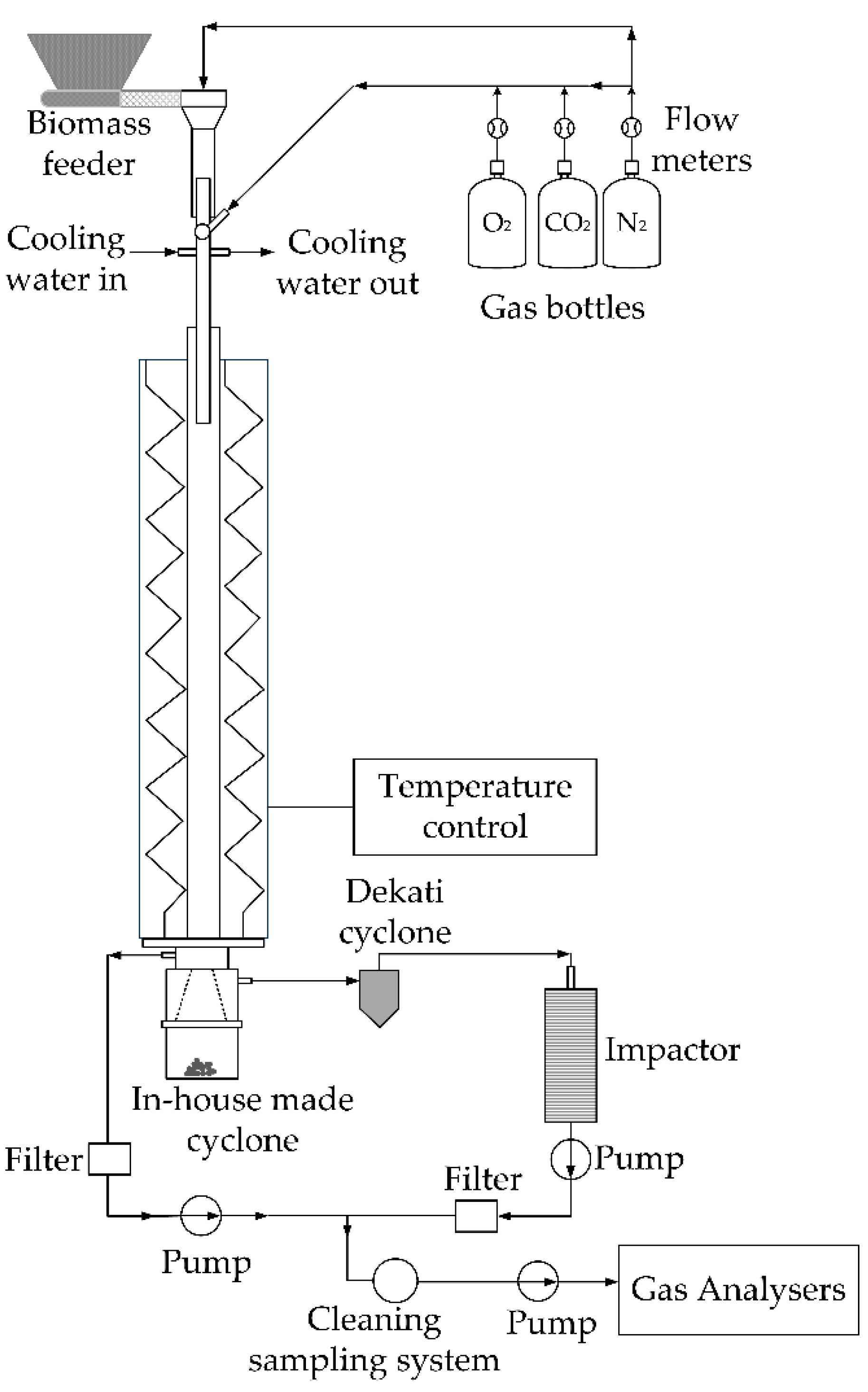
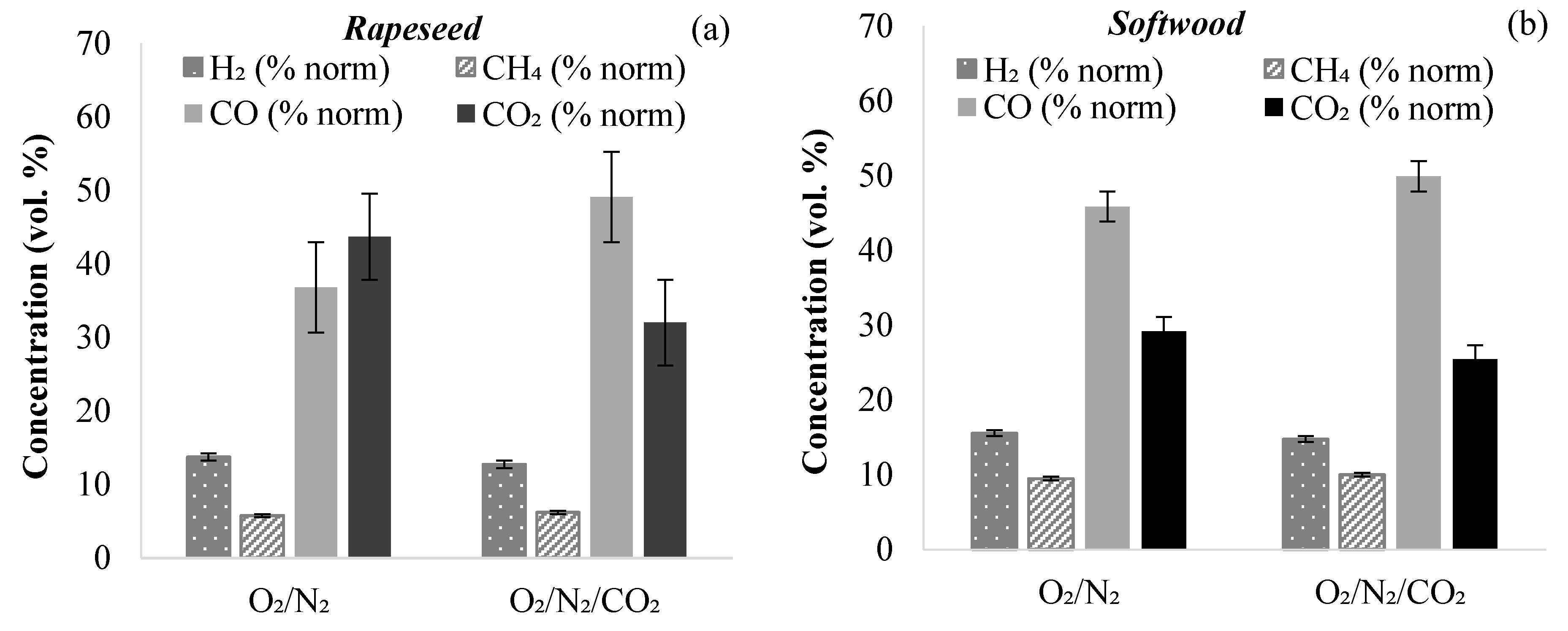
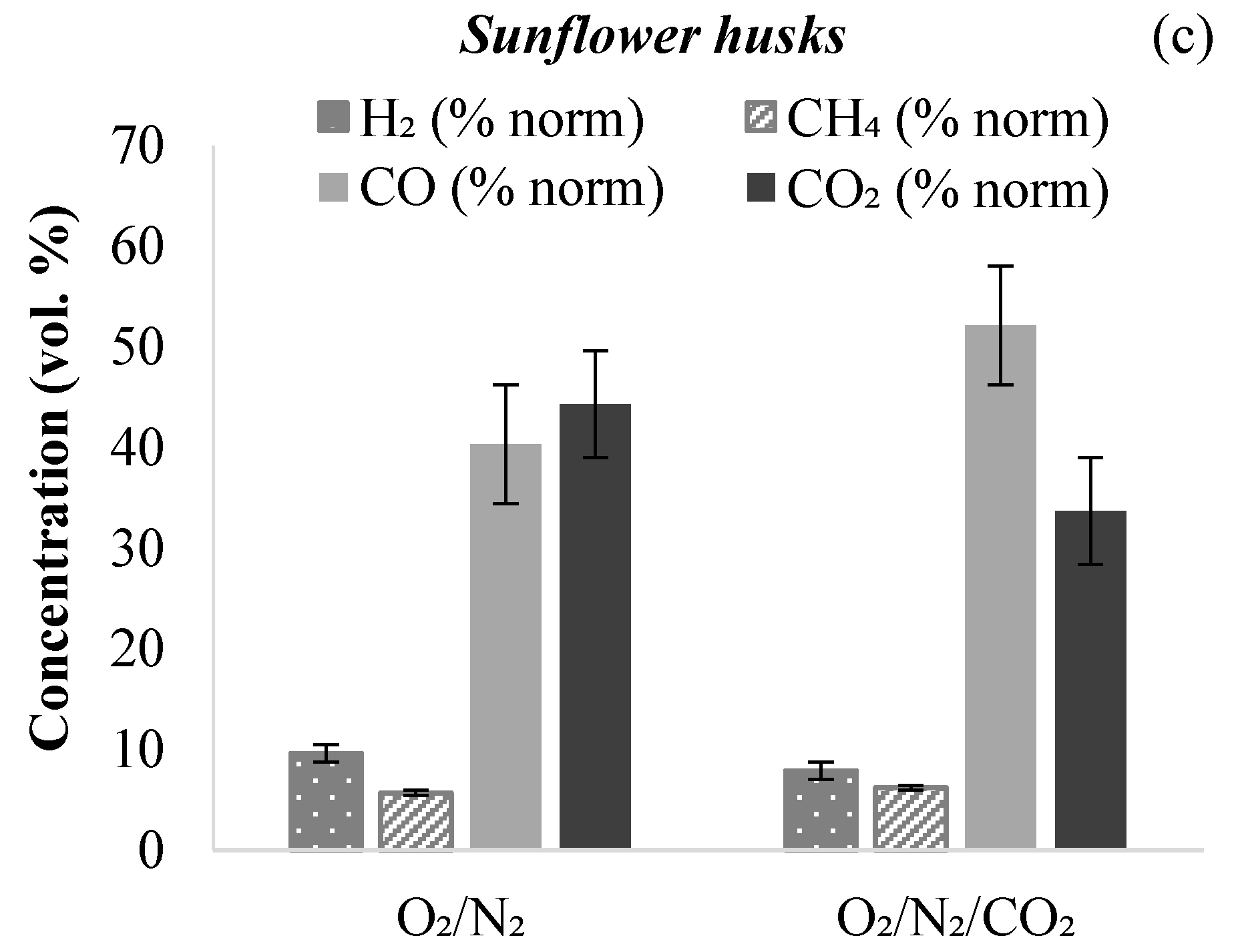
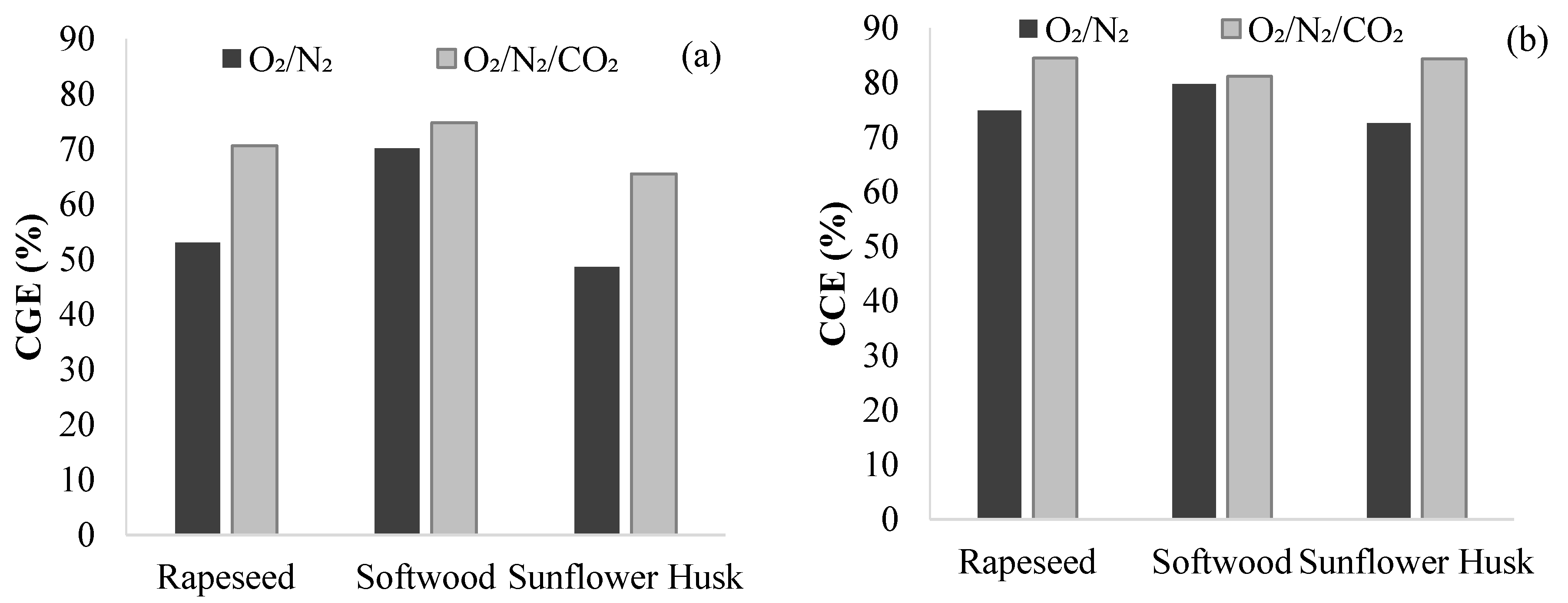
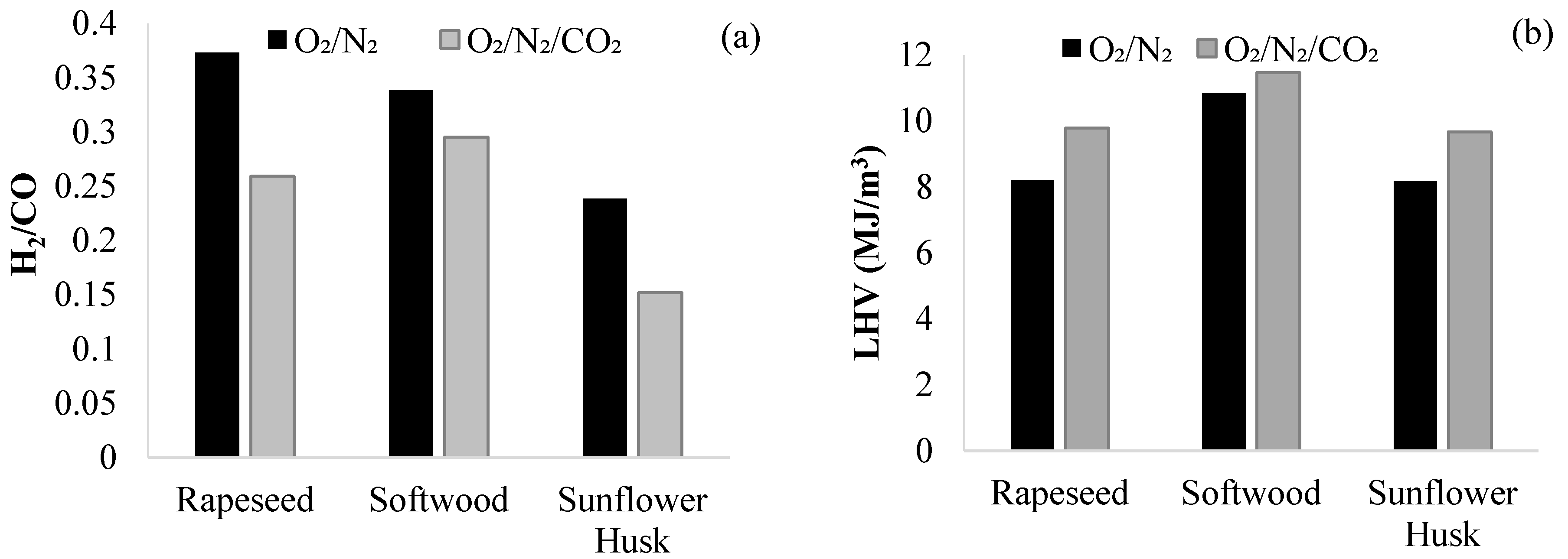
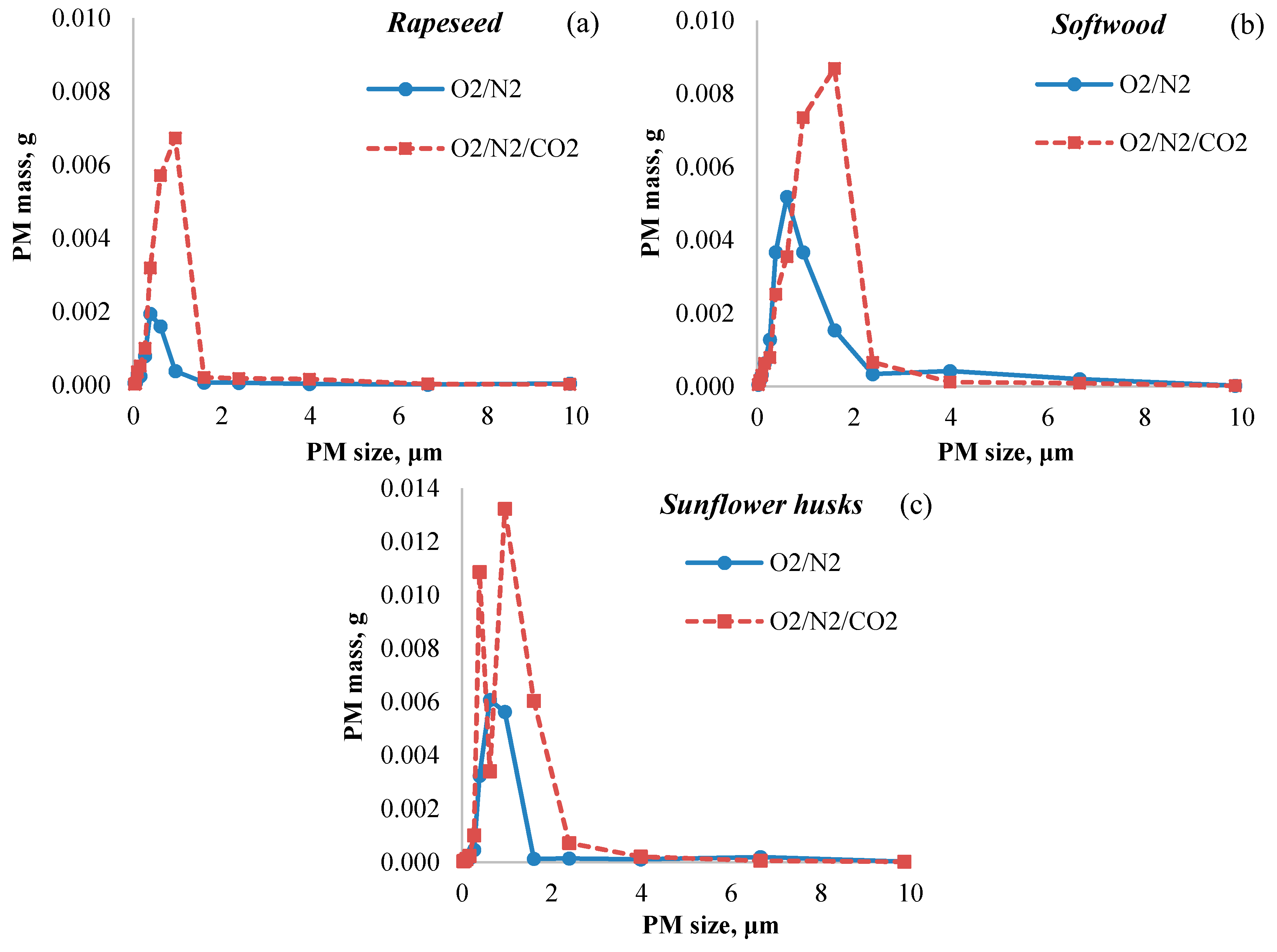
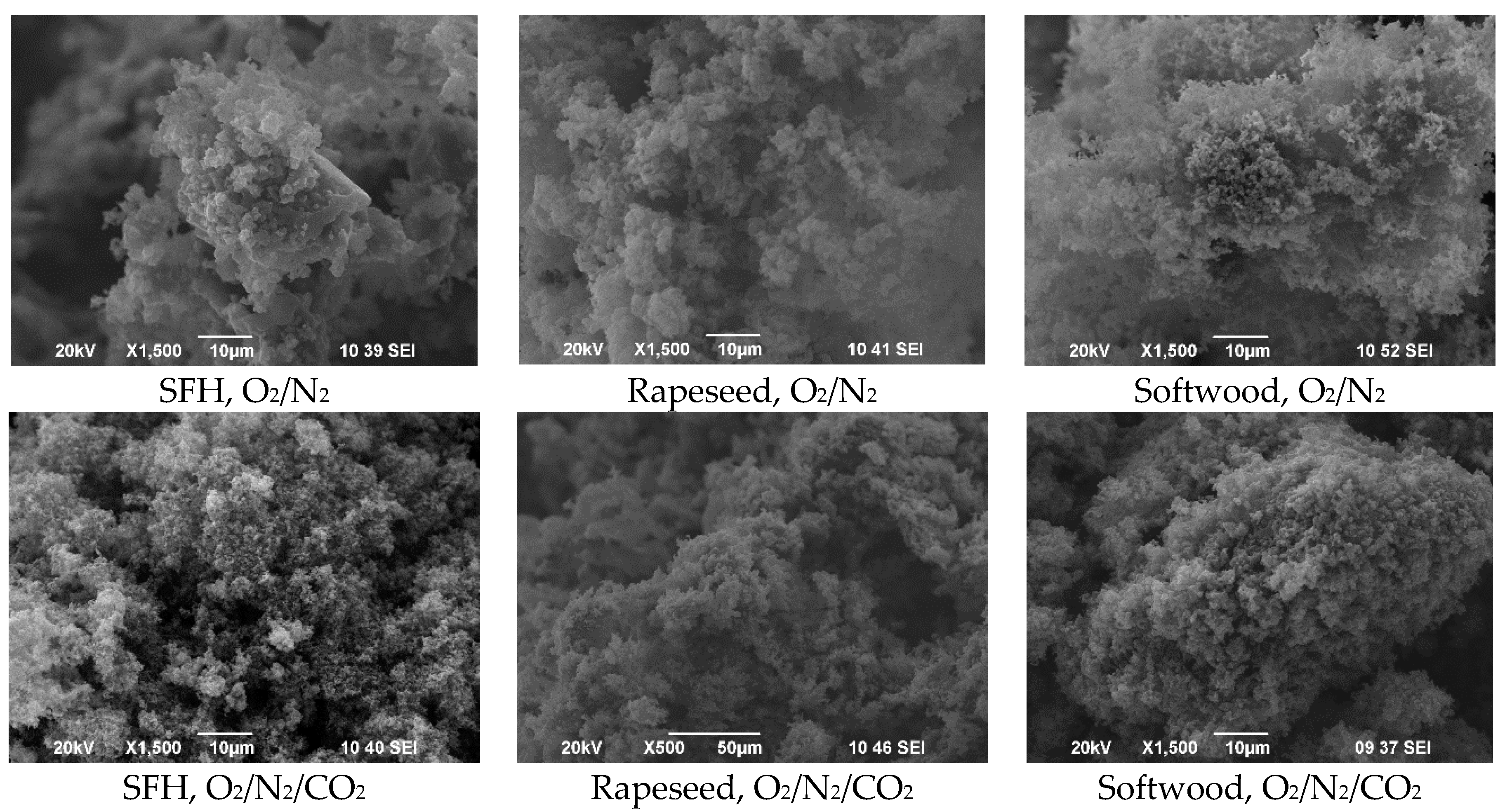
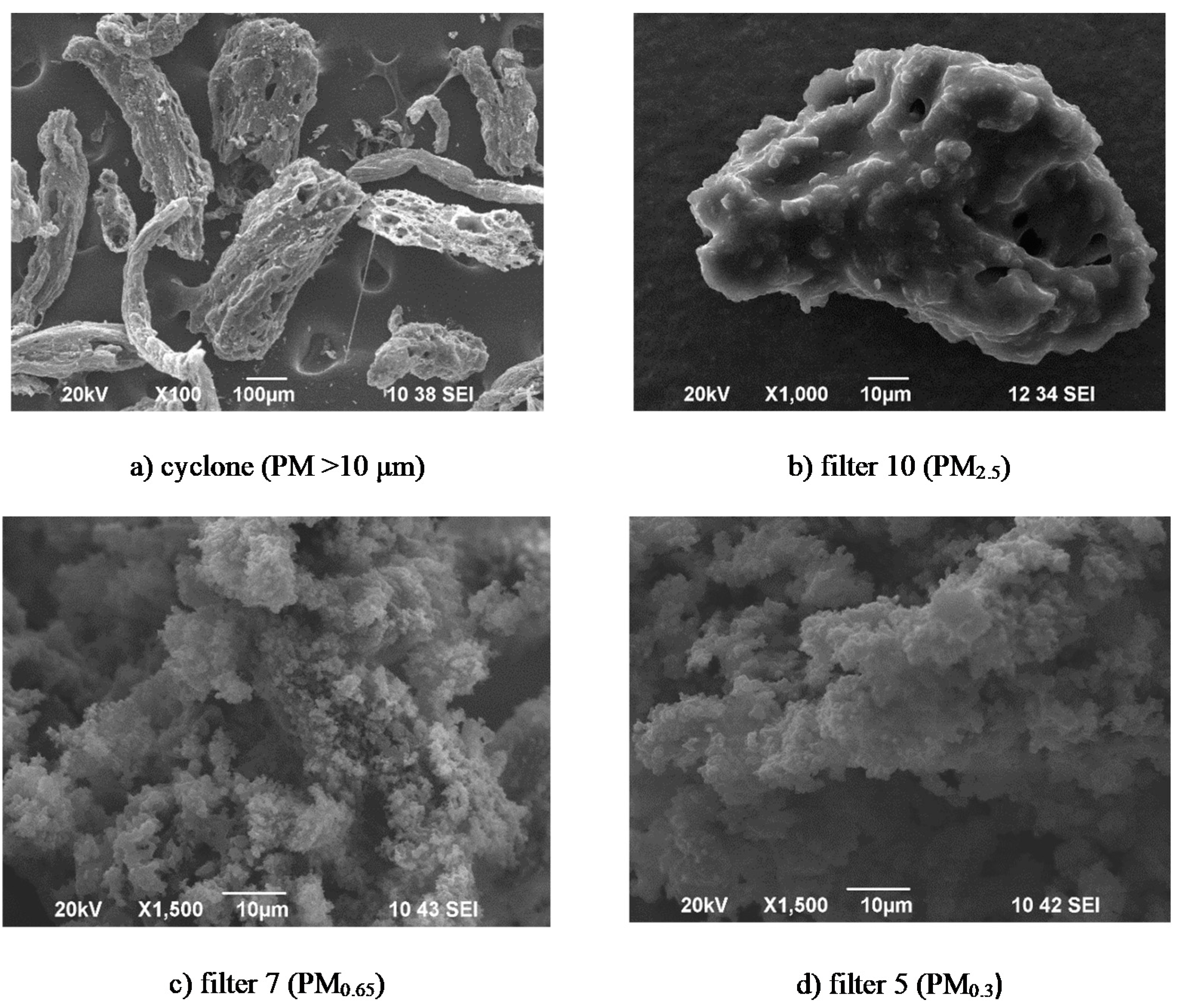
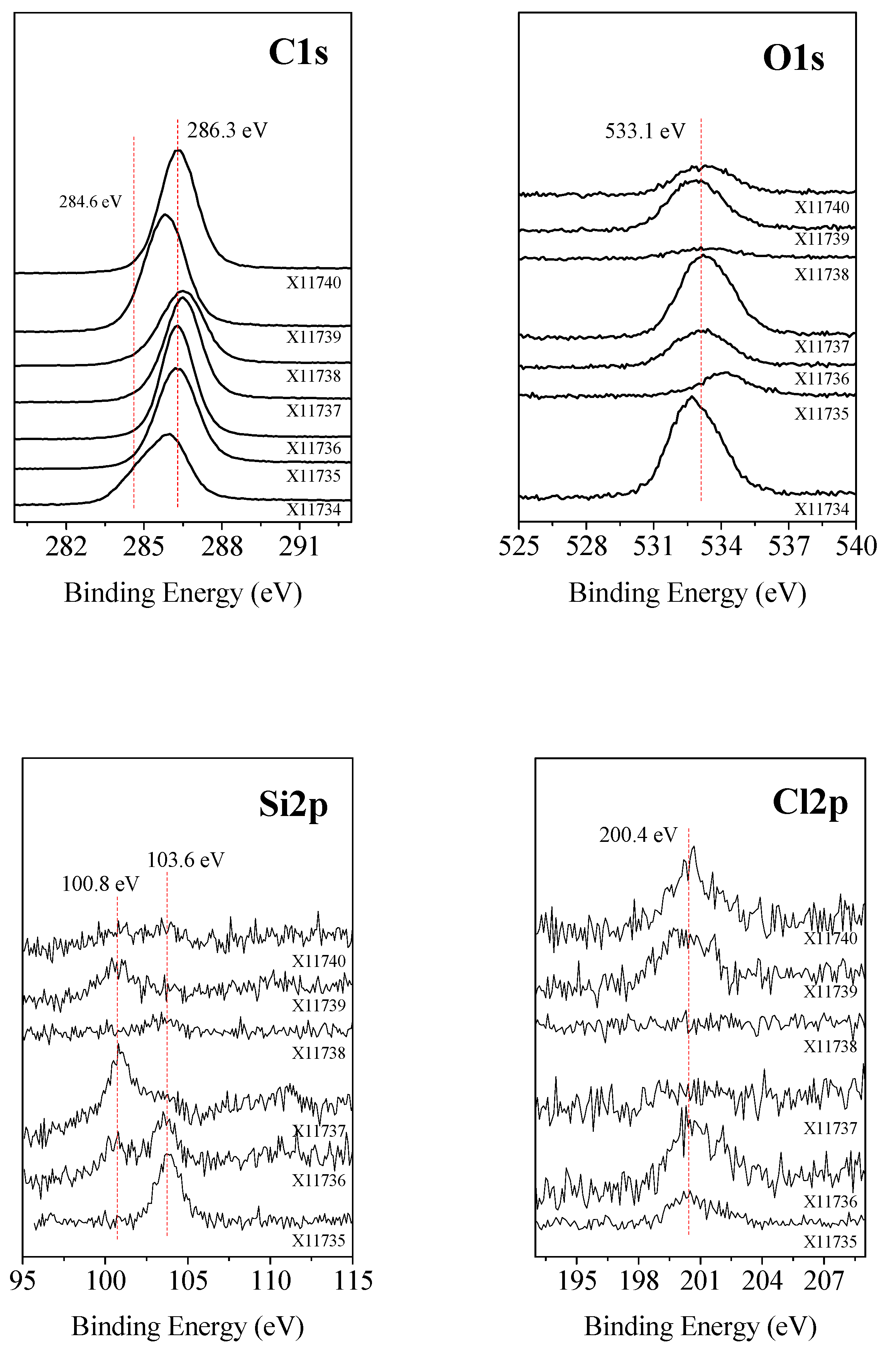
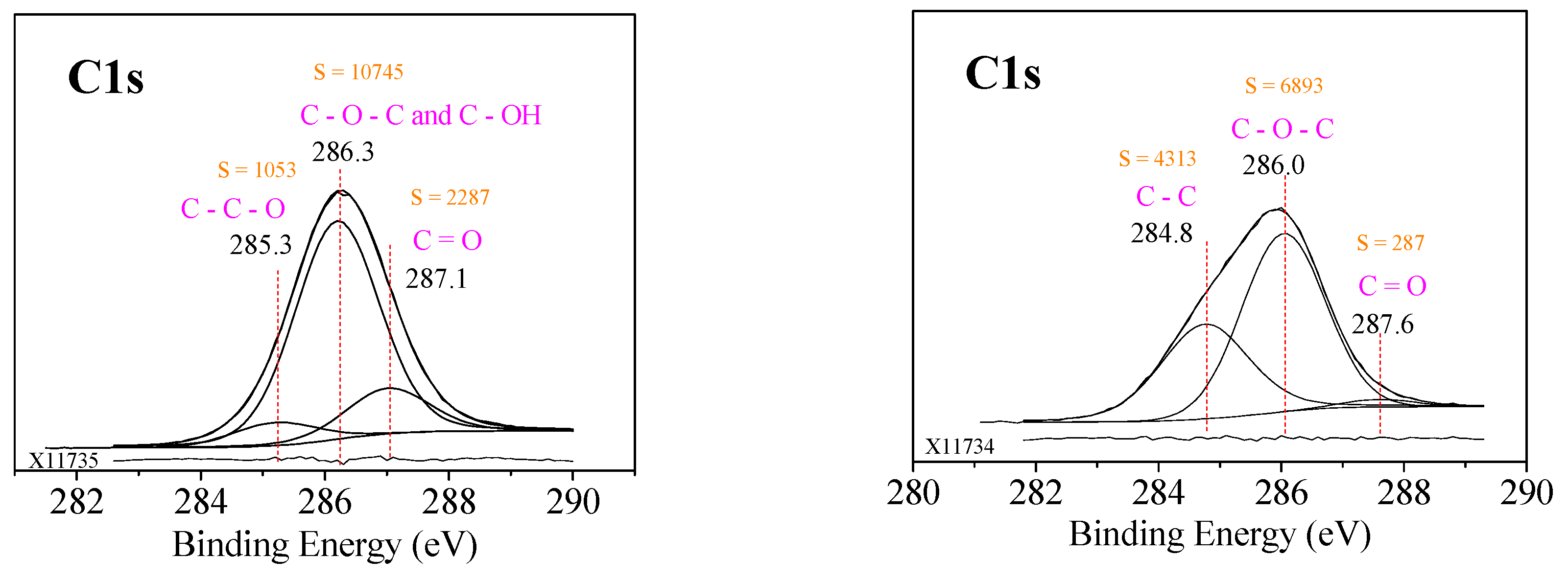
| Parameter Studied | SW | SFH | RP | Parameter Studied | SW | SFH | RP |
|---|---|---|---|---|---|---|---|
| Proximate analyses (wt. %, as analyzed) | Ash analysis (wt. %, dry basis)—normalized | ||||||
| Moisture | 6.89 | 7.52 | 9.86 | SiO2 | 3.60 | 1.44 | 3.32 |
| Ash | 0.65 | 2.88 | 4.59 | Al2O3 | 7.05 | 0.21 | 1.31 |
| Volatile organic compounds (VOC) | 78.77 | 76.93 | 78.53 | Fe2O3 | 2.26 | 1.31 | 0.34 |
| Fixed carbon (by dif.) | 13.69 | 12.67 | 4.59 | MnO | 2.10 | 0.03 | 0.08 |
| Ultimate analysis (wt. %, as analyzed) | CaO | 43.71 | 29.18 | 39.13 | |||
| Carbon | 47.77 | 54.04 | 49.64 | MgO | 9.77 | 17.06 | 12.60 |
| Hydrogen | 6.48 | 8.45 | 8.24 | BaO | 0.24 | 0.01 | 0.07 |
| Nitrogen | 0.14 | 3 | 2.67 | Na2O | 1.29 | 0.81 | 3.34 |
| Sulfur | <0.02 | <0.05 | <0.05 | K2O | 20.69 | 41.08 | 23.96 |
| Chlorine | na | <0.10 | <0.10 | Cr2O3 | 0.01 | 0.10 | 0.01 |
| Oxygen (by dif.) | 38.05 | 23.96 | 24.85 | TiO2 | 0.42 | 0.20 | 0.11 |
| Higher heating value, (MJ/kg, dry basis) | ZnO | 1.22 | 0.09 | 0.01 | |||
| HHV | 20.28 | 20.28 | 18.69 | CuO | 0.04 | 0.04 | 0.01 |
| SrO | 0.01 | 0.03 | 0.03 | ||||
| P2O5 | 7.59 | 8.39 | 15.71 | ||||
| Biomass Gasifying Gas | RP (mg/g, db) | SFH (mg/g, db) | SW (mg/g, db) | |||
|---|---|---|---|---|---|---|
| O2/N2 | O2/CO2/N2 | O2/N2 | O2/CO2/N2 | O2/N2 | O2/CO2/N2 | |
| Cyclone | 139.30 | 85.24 | 146.04 | 69.65 | 110.6 | 76.56 |
| PM-13 | 2.228 | 7.268 | 6.992 | 9.972 | 6.528 | 7.206 |
| Gasifying Gas | Biomass | PM | C | O | Cl | K | Mg | Ca | Cu | Na |
|---|---|---|---|---|---|---|---|---|---|---|
| wt % | ||||||||||
| O2/N2 | SFH | PM1 | 91.88 ± 0.79 | 6.45 ± 0.79 | 0.64 ± 0.09 | 1.03 ± 0.09 | ||||
| RP | 88.08 ± 1.03 | 6.60 ± 1.03 | 2.43 ± 0.18 | 2.89 ± 0.19 | ||||||
| SW | 88.86 ± 1.40 | 11.14 ± 1.40 | ||||||||
| O2/N2/CO2 | SFH | 94.09 ± 1.50 | 5.09 ± 1.50 | 0.17 ± 0.11 | 0.65 ± 0.18 | |||||
| RP | 90.23 ± 1.01 | 4.48 ± 1.00 | 1.92 ± 0.17 | 2.79 ± 0.19 | 0.59 ± 0.27 | |||||
| SW | 94.63 ± 1.21 | 5.31 ± 1.21 | 0.06 ± 0.08 | |||||||
| O2/N2/CO2 | RP | (a) >10 μm | 50.92 ± 1.99 | 28.23 ± 1.89 | 6.75 ± 0.39 | 0.81 ± 0.17 | 12.59 ± 0.63 | 0.7 ± 0.21 | ||
| (b) >10 μm | 72.10 ± 1.58 | 18.30 ± 1.61 | 6.16 ± 0.34 | 0.17 ± 0.11 | 3.26 ± 0.27 | |||||
| (a) PM2.5 | 58.37 ± 2.41 | 39.78 ± 2.38 | 0.25 ± 0.13 | 0.77 ± 0.18 | 0.32 ± 0.15 | 0.52 ± 0.26 | ||||
| (b) PM2.5 | 90.54 ± 1.74 | 6.21 ± 1.75 | 0.56 ± 0.16 | 0.81 ± 0.18 | 1.89 ± 0.33 | |||||
| PM0.65 | 89.68 ± 1.06 | 6.16 ± 1.07 | 1.70 ± 0.14 | 2.28 ± 0.16 | 0.18 ± 0.17 | |||||
| PM0.3 | 87.97 ± 1.54 | 5.27 ± 1.55 | 2.93 ± 0.26 | 3.83 ± 0.3 | ||||||
| Gasifying Agent | Biomass | Specter Name | C | O | Al | Si | Ca | Cl |
|---|---|---|---|---|---|---|---|---|
| at % | ||||||||
| O2/N2 | SFH | X11739 | 89.0 | 5.9 | 4.1 | 0.6 | 0.4 | |
| Rapeseed | X11736 | 89.5 | 4.9 | 4.0 | 0.9 | 0.7 | ||
| Softwood | X11737 | 82.5 | 8.3 | 8.7 | 0.6 | |||
| O2/CO2/N2 | SFH | X11734 | 74.0 | 12.9 | 11.9 | 0.4 | 0.4 | 0.5 |
| SFH (Al-free) | X11735 | 95.7 | 3.0 | 0.0 | 1.2 | 0.1 | ||
| Rapeseed | X11740 | 92.9 | 3.7 | 2.1 | 0.8 | 0.5 | ||
| Softwood | X11738 | 96.1 | 2.2 | 1.3 | 0.4 | |||
Publisher’s Note: MDPI stays neutral with regard to jurisdictional claims in published maps and institutional affiliations. |
© 2021 by the authors. Licensee MDPI, Basel, Switzerland. This article is an open access article distributed under the terms and conditions of the Creative Commons Attribution (CC BY) license (http://creativecommons.org/licenses/by/4.0/).
Share and Cite
Ferreira, R.; Petrova, T.; Ferreira, A.F.; Costa, M.; Inaydenova, I.; Atanasova-Vladimirova, S.; Ranguelov, B. Size-Segregated Particulate Matter from Gasification of Bulgarian Agro-Forest Biomass Residue. Energies 2021, 14, 385. https://doi.org/10.3390/en14020385
Ferreira R, Petrova T, Ferreira AF, Costa M, Inaydenova I, Atanasova-Vladimirova S, Ranguelov B. Size-Segregated Particulate Matter from Gasification of Bulgarian Agro-Forest Biomass Residue. Energies. 2021; 14(2):385. https://doi.org/10.3390/en14020385
Chicago/Turabian StyleFerreira, Ricardo, Tsvetelina Petrova, Ana F. Ferreira, Mário Costa, Iliyana Inaydenova, Stela Atanasova-Vladimirova, and Bogdan Ranguelov. 2021. "Size-Segregated Particulate Matter from Gasification of Bulgarian Agro-Forest Biomass Residue" Energies 14, no. 2: 385. https://doi.org/10.3390/en14020385
APA StyleFerreira, R., Petrova, T., Ferreira, A. F., Costa, M., Inaydenova, I., Atanasova-Vladimirova, S., & Ranguelov, B. (2021). Size-Segregated Particulate Matter from Gasification of Bulgarian Agro-Forest Biomass Residue. Energies, 14(2), 385. https://doi.org/10.3390/en14020385








